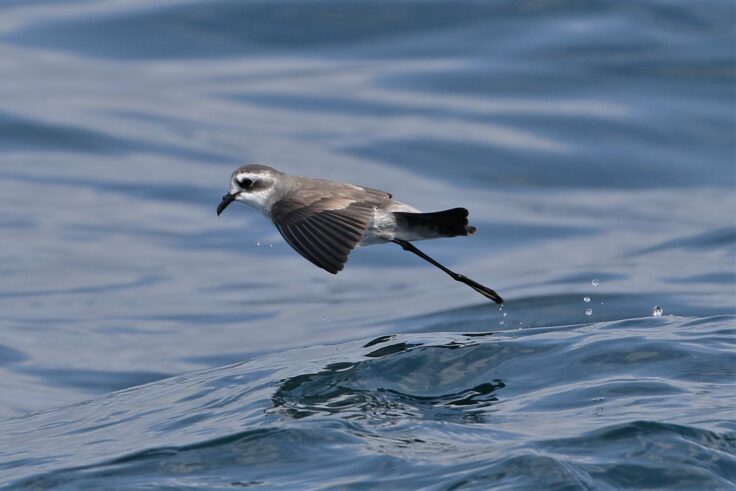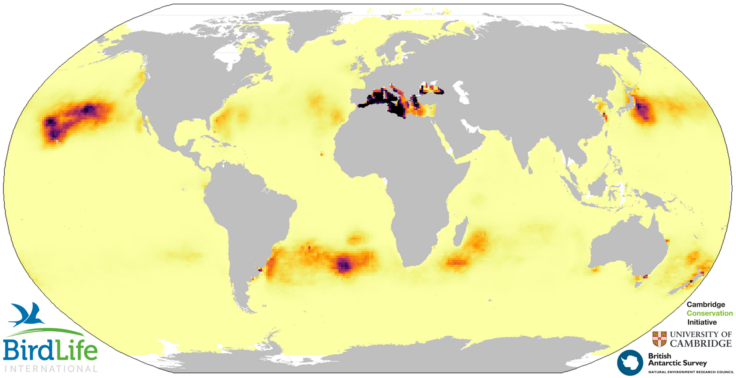Threatened sea birds visit plastic pollution hot spots
Plastic pollution accumulating in international waters poses a serious risk to marine life, including a number of threatened bird species. A huge team of scientists studied the global movements of oceanic seabirds at an unprecedented scale, and compared these movements to maps of plastic distribution in the oceans. This research is published in Nature Communications today.
A quarter of all plastic exposure risk faced by birds occurs in international waters, outside of national boundaries. This is largely linked to gyres – large systems of rotating ocean currents – where vast accumulations of plastics form, fed by waste entering the sea from boats, and from many different countries.
Seabirds often mistake small plastic fragments for food, or ingest plastic that has already been eaten by their prey. This can lead to injury, poisoning and starvation, and petrels are particularly vulnerable because they cannot easily regurgitate the plastic. In the breeding season they often inadvertently feed plastic to their chicks. Plastics can also contain toxic chemicals that can be harmful to seabirds.

The scientists tracked 7,137 individuals of 77 petrel species from 148 populations in 27 countries and Antarctica. Petrels are an understudied but vulnerable group of marine birds, which cover vast distances during foraging and migration and only return to land to breed. They act as sentinels for delicate marine ecosystems and face a complex combination of threats, including predation by invasive species, bycatch in fisheries, climate change, habitat loss, prey depletion, and coastal light pollution, all of which make survival more challenging. In addition, their foraging behaviour and gut morphology make them likely to ingest and retain plastics, reducing their resilience to these threats.
Lizzie Pearmain, a PhD student at British Antarctic Survey and the University of Cambridge and joint corresponding author of the study said:
“Ocean currents cause big swirling collections of plastic rubbish to accumulate far from land, way out of sight and beyond the jurisdiction of any one country. We found that many species of petrel spend considerable amounts of time feeding around these mid-ocean gyres, which puts them at high risk of ingesting plastic debris.”
The study identified key areas where birds are at risk of exposure to marine plastics. The north-east Pacific, south Atlantic, and the south-west Indian oceans have mid-ocean gyres full of plastic waste, where many species of threatened seabird forage. The Mediterranean Sea and the Black Sea are highly polluted and together account for over half of petrels’ global plastic exposure risk, despite only being used by four species. A quarter of all plastic exposure risk faced by birds occurs in international waters, outside of national jurisdictions.

Species were given an ‘exposure risk score’ to indicate their risk of encountering plastic during their time at sea. A number of already threatened species scored highly, including the Critically Endangered Balearic Shearwater, which breeds in the Mediterranean, and Newell’s Shearwater, endemic to Hawaii.
Exposure risk is just one aspect of this threat, and the global prevalence of marine plastic pollution is concerning. Birds can still be at risk when foraging in areas with low estimated plastic levels. Even the species with the lowest exposure risk score, the Snow Petrel, has been previously found to ingest plastic.
Many species of petrel travel vast distances, and a population’s feeding ground may be in an entirely different country’s exclusive Economic Zone (EEZ) from the one where it nests, or it may feed on the high seas, beyond national jurisdictions. Combined with the mobile nature of marine debris as ocean currents circulate plastic pollution far from its sources, this means no one nation or organisation is able to solve the problem alone.
Professor Richard Phillips from British Antarctic Survey, who was a co-investigator on the original funding application, commented:
“By highlighting the huge scale of the potential problem of plastic exposure for petrels, the study provides further impetus to the development of the proposed new UN Treaty on plastics.
However, it is important to note that an International Convention for the Prevention of Pollution from Ships (MARPOL) is already in place, yet much of the plastic pollution in the ocean comes from the fishing and shipping industries. As such, it is clear that attitudes and enforcement need to improve, otherwise the risks posed by plastics to marine wildlife will get far worse, regardless of how many treaties are in place.”
The study was led by a partnership between the University of Cambridge, BirdLife International and the British Antarctic Survey, in collaboration with Fauna & Flora International, the 5 Gyres Institute, and over 200 seabird researchers in 27 countries. It is published today in the journal Nature Communications. This research was funded by the Cambridge Conservation Initiative’s Collaborative Fund for Conservation, sponsored by the Prince Albert II of Monaco Foundation, and the Natural Environment Research Council.
Clark, B.L. et al.: ‘Global assessment of marine plastic exposure risk for oceanic birds’ is published in Nature Communications, July 2023. DOI: 10.1038/s41467-023-38900-z